In our most recent survey, we focused on the different options for treating a kidney stone. This includes both the non-surgical options (letting the stone pass on its own, taking a home remedy to pass/dissolve a stone, taking a medication from your doctor to help pass the stone) and surgical options (shockwave lithotripsy, ureteroscopy, percutaneous surgery).
We wanted to know why patients chose one treatment option over another, how successful was their treatment, how satisfied were they with their treatment, what they liked the most, and what they liked the least about their treatment option. And importantly, we also asked whether they would choose this option again if they needed another stone treatment.
So far, we’ve had 205 responses to the survey, summarized below. We hope that this information will help you to better understand the different treatment options available for treating a kidney stone and allow you to make an informed choice. One disclaimer- not all treatment options are necessarily available for all stones in all patients. As always, we always recommend that you work with your medical professional to choose the best option for you.
The one paragraph summary:
About half of people who responded to this survey underwent ureteroscopy and a quarter underwent shockwave lithotripsy. 14% passed a stone on their own. Most people relied on their doctor’s opinion to help choose their treatment option. Success with treatment ranged from 42% for percutaneous nephrolithotripsy to 70% for ureteroscopy. Not surprisingly, successful stone removal was the most important priority for patients undergoing stone treatment. Having to have a stent, having to wait for treatment, and pain related with treatment were the least liked aspects of stone treatment. For the most part, people were moderately satisfied with their stone treatment, reporting a satisfaction score in the mid 3’s on a scale of 1 to 5 for almost all of the different treatment options. However, people who passed a stone on their own were the least satisfied, reporting the lowest satisfaction score of 2.9. This was also reflected in how likely patients were to consider the same treatment again, with passing a stone on your own having a likely score of 2.9 on a scale of 1 to 5 with “5” being “definitely” and “1” being “not a chance”. All the other treatment options had an average likely score in the mid to high 3’s. Read further if you want all the details and let us know in the comments section whether you agree with these results.
The nitty gritty results:
What type of stone treatment did you have?
About half (45%) of individuals underwent ureteroscopy, 26% underwent shockwave lithotripsy, and 6% underwent percutaneous nephrolithotripsy. Among those who did not have surgery, 14% passed the stone on their own, and 8% took a medication from their doctor. Only 1% of people who responded to the survey reported using a home remedy.
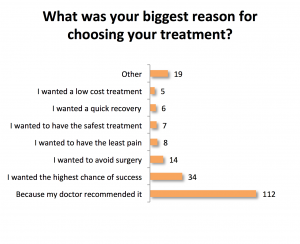 Why did you choose this treatment option?
Why did you choose this treatment option?
The most common reason by far given for choosing a treatment option was because of a recommendation by a doctor. Having a high chance of success was the second most common reason given. “Other” was the third most common and to avoid surgery was the fourth most common reason.
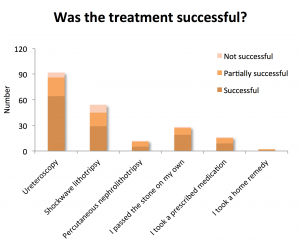 Was the treatment successful at removing your stone(s)?
Was the treatment successful at removing your stone(s)?
Among the surgical treatments, individuals who underwent ureteroscopy had the highest success rate (70%). Shockwave lithotripsy was less successful at 54%. Percutaneous nephrolithotripsy, which is usually used for the largest types of stones, had a lower success rate of 42%. Individuals who tried to pass their stone themselves were successful 68% of the time while those who used a medication or home remedy to help pass the stone were less often successful (56% and 50%).
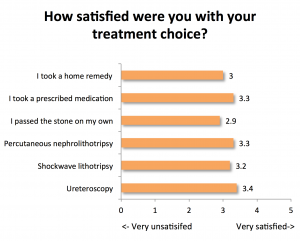 How satisfied were you with your treatment choice?
How satisfied were you with your treatment choice?
For the most part, satisfaction did not differ that much between most of the different treatment choices. Among both surgical and non-surgical treatments, individuals who underwent ureteroscopy were the most satisfied with their choice, with an average score of 3.4 on a scale of 1 to 5, with 5 being the most satisfied. This was followed by using a medication to pass a stone (3.3), percutaneous nephrolithotripsy (3.3), shockwave lithotripsy (3.2), and using a home remedy (3.0). Individuals who passed their stone on their own stood out as being the least satisfied with their choice, reporting an average satisfaction score of only 2.9.
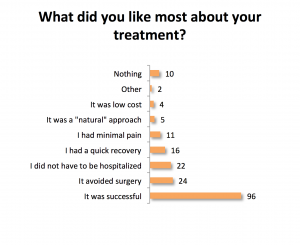 What did you like most about your treatment?
What did you like most about your treatment?
When asked about what they liked most about their stone treatment, successful removal of their stone clearly mattered the most, reported more commonly than all other responses combined. Avoiding surgery and not having to be hospitalized were the second and third most liked feature of treatments reported.
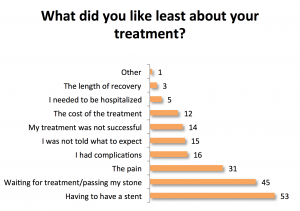 What did you like least about your treatment?
What did you like least about your treatment?
Given the amount of discomfort that many patients experience with stents, it is not surprising that having to have a ureteral stent was the most disliked aspect of treatments reported. The wait time before being treated or passing a stone was the second most common disliked aspect of a treatment. Pain related to treatment was the third most commonly reported disliked aspect.
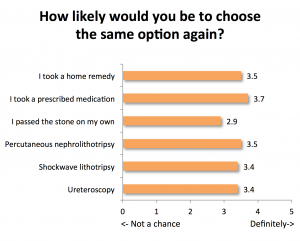 If you had a choice, would you choose this option again?
If you had a choice, would you choose this option again?
Individuals who used a prescribed medication to pass their stone were the most likely to choose this option again, with an average score of 3.7 on a scale of 1 to 5, with 5 being most likely. This was followed by those who used a home remedy who had a score of 3.5. Of the surgical treatments, ureteroscopy and shockwave lithotripsy, had similar likely scores of 3.4 while percutaneous nephrolithotripsy had a slightly higher score of 3.5. Individuals who attempted to pass their stone on their own stood out as being the least enthusiastic about choosing this option again with a score of 2.9.
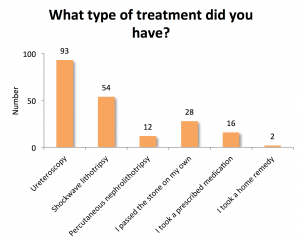
hi. may i know the range of year of the researched statistic??? cause i wan to make it as a references in my case study book. thanks!
I had a lithotripsy procedure for a 6mm stone last summer. I was discharged from the hospital on the same day, and ended up back in the ER for uncontrollable pain, vomiting, and fever about 10 hours later. It was a pretty unpleasant experience. A few particles of the stone passed over the next few days, but it was approximately 6 weeks until the remaining stone (now just over 4mm) passed. Those were not fun weeks – lots of pain, nausea, etc. Based on that experience I think I would be interested in another treatment method next time, if the chances of a quick resolution to the issue were better. My doctor felt strongly that his ’emergency’ lithotripsy plan (4 days after the stone made its presence known) was the only viable option but after going through all of that I wish I had known more or gotten a second opinion. Is one procedure preferred or more effective for recurrent stones? I have at least two more in the 3 – 5 mm range.
That is exactly what has happened to me, And I have had many of these stones , but the doctor refused to give me any more percocet, ( which He always did post surgery for 15 years, as long as I’ve had this, and about 11 lithotripsies ), I had the stent for 8 days, and the day after they pulled the stent I went back on the meds for another 48 hrs. (lots of gravel & 1- 3mm so far), then I ran out. So I called the office and they told me the doctor said He gave you 30 and that should be more than enough. I won’t be able to take it much more and will then have to do the emergency room at $500, after all I’ve already paid and been through. I just don’t understand what happened ? Can it really be that the “OPIOD” crisis has taken presidence over individual care and treatment for diseases like this, which can produce these random multiple episodes of searing pain?, Just depressed
I had lithotripsy surgery on my third trip to the ER and after 5 days in the hospital. My stone was stuck. There was no way it was going to pass. It wasn’t that big, 3.5mm, but it was stuck. I had one lithotripsy where the stone could not be reached because of significant inflammation in the utterer so a stent was placed to allow the utterer to heal. A few weeks later, I had another lithotripsy where the stent was removed along with the stone. Another stent was placed with a string after the second lithotripsy. After four days the stent was pulled out by my doctor with absolutely no pain. It was no big deal. The stents never really hurt that much when they were in. I had only a little pain. The real issue was the constant urge to pee. It was driving me crazy. Once the last stent was pulled out, the urge to pee completely went away. It was like turning a light switch off. It was that immediate. The urge to pee was really the worst part of the whole process. Flomax did help somewhat along with drinking plenty of water. Would recommend the procedure. I would do it again if necessary. Pulling the last stent out via string did not hurt at all. It was not big deal.
I have been dealing with stones for about 10 years or so, always being able to pass with pain meds and plenty of fluid. Intil about 2 months ago. I had a very similar experience, but with a few hiccups. I had a 4.5 mm that I was scheduled for surgery. During the procedure they punctured a hole in my uretor then they noticed the stone was obstructed. Internal Stent put in. 3 days in hospital and scheduled for Litho. My 2nd. This time it didnt work. Passed very few tiny particles. 2 weeks of on and off pain with 2 ER visits. Finally scheduled for outpatient surgery on a Monday. The Sunday before forced to go back to ER for blood and awful pain. Thought I had an infection from the stent being in too long. Surgery cancelled. 3 days later turns out I didnt have an infection. Blood was from the Stent and Stone. 2 more days in hospital finally scheduled for surgery to remove stent and stone. Successful, but new stent was left in, with a string this time. The anxiety i felt about the stent was definitely worse than the actual pull. Don’t get me wrong it sucked pulling it out and I had some tearing on the head of my junk from the suture string. A couple days and Neosporane did the trick. As of today no pain, but I was informed there are more stones in my kidney that are dormant, but will cause issues down the road. Its hard to make people understand what a awful experience this is unless they get them. People hear kidney stones and its always “ouch”. Its an all encompassing problem that can affect every part of your life. All I can say is Keep the Faith and Keep Straining
I had lithotripsy surgery that was a breeze! I had been really sick with the kidney stone, no pain, vitals dropped fast and became rigors, was in hospital 3 days. Removal of stone was great, no side effects, no pain! Would recomend it!
[…] ← Introducing KidneyStoners.org polls and surveys Survey Results: Were you happy with your stone treatment? → […]
Geoege (George?):
Unfortunately your experience is not an uncommon one.The first step in percutaneous surgery to remove a kidney stone is successfully passing a small catheter/wire from the skin into the kidney. Percutaneous surgery involves passing a scope through the flank into the kidney then using a variety of devices to break up the stone prior to removing the pieces. The first step of succesfully placing a wire into the kidney can often be difficult due to either stones being very large or the space needed to get the catheter/wire in very small. I would recommend that patients with stones considering percutaneous surgery be seen by physicians or centers who specialize in that technique who have a large experience in performing this procedure. The initial step of placing the wire or tube can be safely done by radiologists or urologists. The key is finding a phsician/center that has a large experience in performing this procedure. As with any surgery, there are inherent risks which include treatment failure that can occur wherever you go. I believe these risks can be minimized by seeking specially trained physicians and centers of excellence.
I had percutaneous lithotripsy done and the Dr. could not get the tube in my kidney went home with pain meds., about a month later the dr. tried to crush stone, xray after showed it broke it up some but still did not pass stone, now dr. wants to try percutaneous lithotripsy again and if he has trouble will roll me over and go thru my bladder to get it. I have been very disappointed thus far but don’t know what else to do except try again, the stone was about 2″ to begin with.